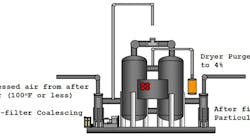In brief:
- The low moisture content in purge air is what regenerates the desiccant bed.
- The liberated heat of adsorption has a limited effect on bed regeneration.
- Many heatless dryers are subjected to suboptimum applications that can hinder performance.
True or false? Low inlet moisture load to a heatless desiccant dryer can have a negative effect on performance because it detracts from the heat of absorption.
Figure 1. The heatless regenerative dryer can be a real workhorse if you understand its operational characteristics.
This theory has been discussed and promoted over many years by many in the industry and even used by some people involved with dryer design and application. During the past decade, a great deal of research and testing has been focused on this subject. The results are that subjecting heatless desiccant dryers (Figure 1) to low-moisture inlet air actually delivers lower dewpoints because there’s less moisture to remove from the desiccant bed and, therefore, less work to be done.
Testing of a heatless dryer at a plant in Illinois revealed that, with a lower moisture load and lower inlet air temperature from the compressor, the unit regularly provides a -60° F pressure dewpoint during the summer and -100° F to -120° F pressure dewpoint during the winter. The primary driver that moves moisture from the desiccant bed is the low relative humidity of the purge rather than the heat of absorption.
At 100 psig, purge air that a heatless dryer requires for proper tower regeneration is found by dividing atmospheric pressure, 14.7 psia, by 114.5 psia (100 psig + 14.7 psia), or 12.7%. That is, to say, at a constant temperature, 12.7 scf of air at atmospheric pressure can hold the same amount of moisture as 100 scf of compressed air at 100 psig.
[pullquote]The calculated purge rate is increased to 15% to compensate for the fact that the dryer doesn’t purge continuously, but it interrupts purging to re-pressurize, and the purge air leaving the desiccant approaches saturation. When a cubic foot of -40° F pressure dewpoint, 100-psig purge air is expanded into the regenerating tower, the purge air dewpoint drops to -70° F atmospheric dewpoint, which can hold seven to eight times more moisture in vapor form.
The expansion effect on the purge air dewpoint is the primary mechanism at work in a heatless dryer (Figure 2). The liberated heat of adsorption is a byproduct of moisture leaving the beads as the desiccant regenerates. It has a positive but limited effect on the relative humidity difference required to move the moisture. The effect of the purge air expansion, along with the significant volume of purge, is what makes a heatless dryer function.
Figure 2. A heat of compression dryer functions by recovering the hot purge air that might require a source of external heat during some conditions. Often it can deliver desiccant dry air with little or no significant energy use or lost purge air.
Heatless dryers often can be equipped with vacuum-assist purge air (Figure 3) to reduce purge air regeneration to a nominal 3 psia, which increases the expansion ratio to 2.6%, or 2.6 scf of air. At atmospheric pressure, 2.6 scf can hold the same amount of moisture as 100 scf of compressed air at 100 psig. This allows a 4% purge rate (theoretical 2.6% purge). You see here the effect of the improved purge air from the expansion effect.
Figure 3. Using a vacuum assist heatless dryer reduces the amount of purge air required.
Unless you’re an engineer designing dryers, why is this important? Because of this misconception, we often observe heatless dryers subjected to suboptimum applications that limit or even hinder performance. For example, aftercoolers that could deliver colder, dryer air to the heatless dryer are reset to deliver hotter, wetter air, thus adding to dryer loading. Or, while a powerhouse air supply might use an effective heat of compression or blower purge dryer to supply dry air to the whole plant, a secondary user requiring a stringent -40° F to -100° F pressure dewpoint might avoid the too-dry powerhouse air and set up a needless, less efficient, smaller air supply to feed a single heatless dryer.
The problem with the second point is that it results in a more moisture-loaded dryer, less power-efficient compressed air supply, more purge, and another remote compressor for the maintenance crew to worry about.
As always, don’t let apparent rules of thumb, which really are rules of dumb, lead you astray.
Hank van Ormer owns Air Power USA (www.airpowerusainc.com). Contact him at [email protected] and (740) 862-4112.
